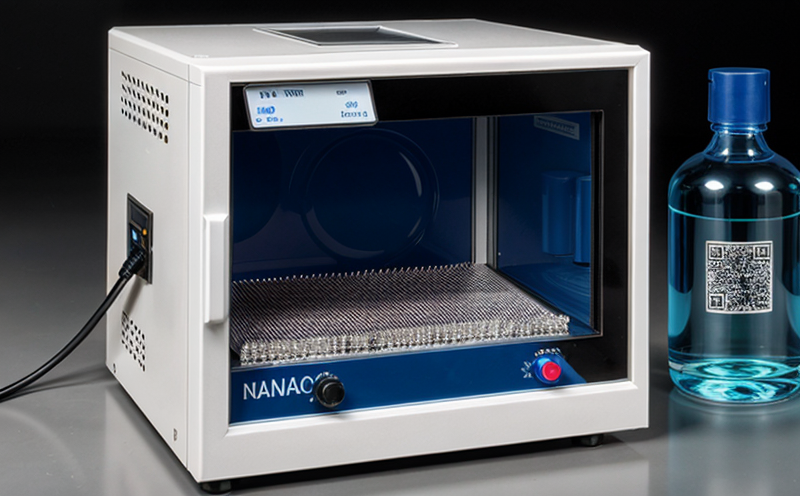EN 17273 Nanomaterial Toxicity Testing in Consumer Products
The European Standard EN 17273 is a critical tool for assessing the toxicity of nanomaterials present in consumer products. This standard ensures that manufacturers and producers can demonstrate compliance with health, safety, and environmental regulations. The focus on nanochemical analysis in this context emphasizes the unique properties of nanoparticles which may not be evident when dealing with bulk materials.
The scope of EN 17273 includes a range of consumer products such as textiles, cosmetics, electronics, paints, and coatings where nanomaterials are commonly used. The standard is designed to identify potential adverse effects on human health and the environment that could arise from exposure to these nanochemicals.
One of the key aspects of EN 17273 is its requirement for detailed characterization of the nanomaterials involved in the product. This includes understanding their size, shape, composition, and surface properties which are crucial for assessing toxicity. The standard also requires a comprehensive risk assessment that takes into account both acute and chronic exposure scenarios.
For accurate testing under EN 17273, precise specimen preparation is essential. This involves careful handling of nanomaterials to avoid contamination or degradation. Additionally, the method used for dissolution or dispersion of these materials directly impacts the reliability of toxicity tests. It’s important that the chosen method accurately represents real-world exposure conditions.
The standard also specifies the use of appropriate analytical techniques such as inductively coupled plasma mass spectrometry (ICP-MS) and transmission electron microscopy (TEM) to characterize nanomaterials. These advanced tools are necessary for capturing the complexities of nanochemical properties that can influence toxicity outcomes.
EN 17273 places significant emphasis on ensuring reproducibility and repeatability in testing procedures. This is achieved through standardized protocols, trained personnel, and quality-controlled reagents and equipment. Reproducibility ensures that results are consistent across different laboratories and batches of samples, which is critical for regulatory compliance.
In summary, EN 17273 provides a robust framework for the toxicity testing of nanomaterials in consumer products. By addressing key aspects such as specimen preparation, analytical techniques, risk assessment, and reproducibility, this standard helps ensure that nanochemicals are used safely and responsibly within the European Union.
International Acceptance and Recognition
The acceptance of EN 17273 extends beyond Europe, with numerous countries adopting it as a benchmark for nanotoxicology. The standard is recognized by regulatory bodies worldwide, including the US Environmental Protection Agency (EPA) and the Canadian Department of Environment.
Adoption of this standard benefits manufacturers who can harmonize their testing protocols across different regions, reducing costs and time spent on compliance. It also fosters innovation in the development of safe nanomaterials by providing a clear roadmap for toxicity assessment.
The widespread recognition of EN 17273 underscores its importance in ensuring global standards for the safety and sustainability of consumer products containing nanomaterials. This harmonization supports international trade and cooperation, particularly in sectors like electronics, textiles, and cosmetics where nanochemical analysis plays a significant role.
Environmental and Sustainability Contributions
- Eco-friendly Product Development: By ensuring that nanomaterials used in consumer products are safe for human health and the environment, EN 17273 promotes eco-friendly product development. This reduces the risk of environmental contamination and ensures sustainable practices.
- Reduction in Waste: The standard helps minimize waste by identifying potentially harmful nanomaterials early in the production process. This leads to more efficient use of resources and lower environmental impact.
- Sustainable Manufacturing Processes: Compliance with EN 17273 encourages manufacturers to adopt sustainable manufacturing processes, which can reduce energy consumption and carbon footprint.
The adoption of such standards is crucial for achieving the United Nations Sustainable Development Goals (SDGs), particularly Goal 12: Responsible Consumption and Production. By ensuring that nanomaterials are used responsibly, EN 17273 contributes to a more sustainable future by promoting circular economy principles.
Use Cases and Application Examples
Cosmetics: In the cosmetics industry, EN 17273 is particularly relevant for products like sunscreens that contain nanoparticles of zinc oxide or titanium dioxide. These materials are used to provide broad-spectrum UV protection while being highly effective in minimizing visible white residue on the skin.
Electronics: Nanomaterials are integral to many electronic devices, from smartphones and laptops to wearable tech. The standard ensures that these nanomaterials do not pose risks during use or disposal of the products.
Texiles: Textile manufacturers often incorporate nanoparticles into fabrics for enhanced properties such as water repellency or antimicrobial treatments. Testing according to EN 17273 helps ensure that these textiles are safe and compliant with international standards.
Paints and Coatings: In the coatings industry, nanomaterials can improve durability and resistance against environmental factors like UV radiation and moisture. The standard ensures that these properties are achieved without compromising safety or sustainability.





